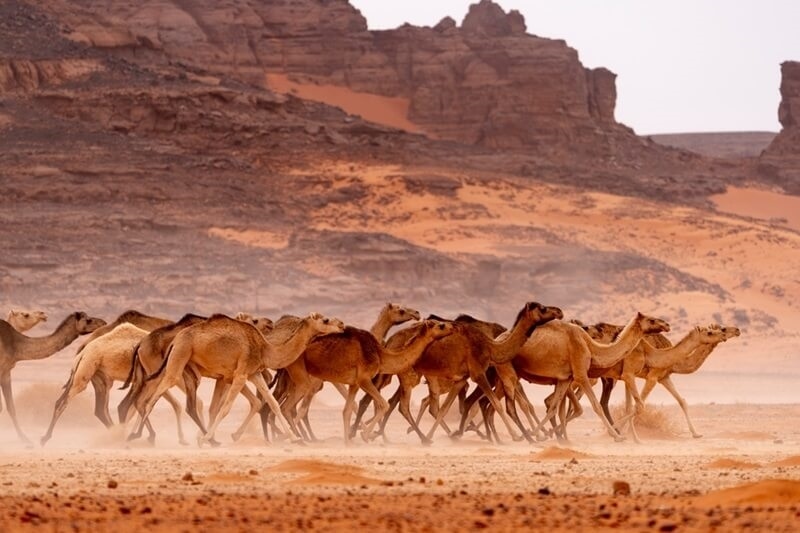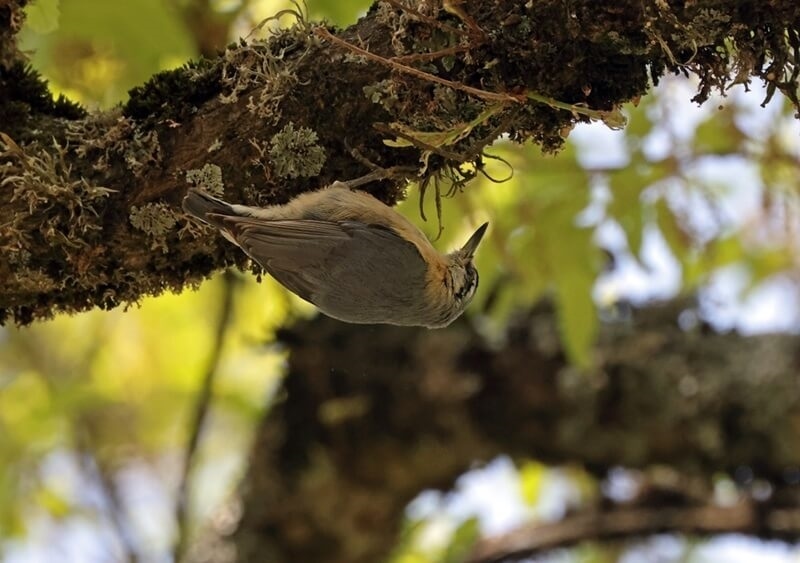
You can’t really understand Algeria until you step outside its cities. Away from the buzz of Algiers or the busy ports of Oran, the land changes — quietly, completely. The air thins. The light sharpens. Somewhere between the green hills of the north and the endless dunes of the south, life begins to move differently. This is Algeria wildlife — raw, untamed, and astonishingly alive.
Most travelers picture Algeria as a desert. It is, mostly. But it’s also cedar forests, mountain ridges, wetlands full of birds, and valleys where foxes leave tracks in the sand. The country stretches across climates like few others in Africa, and nature here still feels untouched.
Talking about Algeria wildlife means talking about contrast. One day you can watch flamingos feeding in a coastal lagoon; the next, you might see a fennec fox darting through moonlit dunes. That’s the rhythm of this country — extremes sharing the same heartbeat.
In the north, the landscape rolls gently into the Mediterranean. Olive groves, lakes, cedar trees. It’s calm here, soft even. Then you head south, and everything shifts. The Sahara opens up like an ocean of silence — golden, endless, almost intimidating. But even there, life refuses to surrender.
Algeria’s wilderness stretches across 2 million square kilometers, but it never feels empty. It feels watchful. The animals don’t show off; they hide, waiting for patience. And if you take your time, the desert starts whispering back.
It takes a special kind of grace to survive the desert. The Sahara animals that call Algeria home are masters of endurance. Every movement, every sound, every shadow has purpose.
The fennec fox is probably the desert’s most famous face. Small, with ears too big for its head, it looks fragile. But those ears aren’t just cute — they cool its blood and catch the faintest rustle of prey. Then there’s the addax antelope, pale as moonlight, whose spiral horns cut through the air as it walks across dunes that could swallow a car whole.
At dusk, jerboas hop across the sand like miniature acrobats. Reptiles, from geckos to sand vipers, leave trails that wind and vanish with the wind. Scorpions glow faintly under ultraviolet light. And when the night falls silent, you might hear a jackal’s distant cry, carried by the breeze.
The Sahara looks barren, but the truth is, it’s alive — if you know how to look. The Sahara animals don’t need attention. They’ve been here far longer than us, thriving where nothing should.

If you lift your eyes instead of your camera, you’ll notice the sky over Algeria never sits still. It’s a migration highway, a pathway for thousands of Algerian birds that cross continents every year.
In the wetlands of El Kala and Annaba, pink flamingos gather by the hundreds, their reflections turning the water into watercolor art. Storks perch on rooftops in small villages, nesting so comfortably among people that no one even looks twice anymore.
Head to the Atlas Mountains and you might spot a golden eagle, wings spread wide, gliding effortlessly on the warm air. Falcons dive so fast you almost miss them. And in the desert, smaller species — desert larks, sandgrouse, and hoopoes — flash between rocks, turning dust and motion into color.
Birdwatching here isn’t just about spotting rare species. It’s about watching the sky tell its story — one wingbeat at a time. The Algerian birds don’t just decorate the landscape; they define its rhythm.
You won’t find luxury lodges or safari jeeps here. The best wildlife spots Algeria has to offer are hidden, scattered across a land that refuses to be tamed.
Tassili n’Ajjer National Park is one of the most extraordinary places on Earth — a high plateau of sandstone towers, ancient rock art, and secret valleys. It’s a UNESCO site, yes, but also a refuge for desert foxes, Barbary sheep, and tiny reptiles that blend perfectly into stone. The silence here feels sacred.
Move north and you’ll reach Djurdjura National Park, a complete change of scenery. Snow dusts the cedar trees in winter, and monkeys — actual wild Barbary macaques — leap from branch to branch. They watch you with a mix of curiosity and mischief.
Closer to the coast, El Kala National Park bursts with wetlands, forests, and shimmering lakes. It’s green, humid, and alive with birds. For many, this park is where they finally understand how diverse Algeria really is. Among all the wildlife spots Algeria hides, this one hums with life in every direction.
Here’s the thing — you can’t rush nature here. Nature watching Algeria isn’t about instant gratification. It’s about waiting long enough to see the story unfold.
Local guides, often descendants of nomadic families, know the signs — a paw print half-buried in sand, a distant movement on a ridge, the faint call of a bird you might have mistaken for wind. They teach you how to look properly, how to listen.
The trick is to slow down. Sit by a desert well at dawn, and you’ll notice how the world wakes gently — first the insects, then the birds, then the rustle of fur somewhere in the distance. In the mountains, the scent of pine mixes with the sound of water running cold and fast.
The best moments of nature watching Algeria are the quiet ones — no tour bus, no crowd, just you and the land, both learning each other’s pace.
In Algeria, people and wildlife share more than just space — they share survival. From the Tuareg in the Sahara to farmers in Kabylie, every community here understands nature differently. It’s not something to conquer; it’s something to live with.
Nomads still follow the rhythm of seasons. Their camels graze where gazelles once did. Shepherds lead flocks across mountain passes, careful not to disturb nesting birds. The knowledge they carry isn’t written in books — it’s learned from wind, from stars, from generations who listened to the land.
That connection, quiet but enduring, keeps Algeria’s wilderness alive.
For travelers, the idea of wildlife tours in Algeria might sound new. But it’s growing — carefully, responsibly. These aren’t commercial safaris; they’re small, local-led adventures that let you experience nature without harming it.
You can join treks through Hoggar National Park, camping under the stars while Tuareg guides share stories about constellations and desert legends. Bird enthusiasts can explore the wetlands near El Kala, binoculars ready as flamingos take flight in pink waves. In Djurdjura, hikers follow forest trails in search of macaques, breathing in the scent of cedar and cold air.
What sets these wildlife tours apart is intention. They don’t just show you animals; they show you relationships — between land and life, between silence and sound. You leave not with souvenirs, but with perspective.
Every season in Algeria paints its own scene. Spring is full of motion — wildflowers in the north, migrating birds overhead, gazelles chasing new grass in the desert. Summer slows everything down. The Sahara burns, the air shimmers, and most life hides until the stars rise.
Autumn brings back movement. The dunes cool, and animals emerge again. It’s also when photographers love to visit — the light turns golden, soft, cinematic. Winter belongs to the mountains, where snow blankets the forests, and Barbary macaques huddle close against the cold.
The beauty of this land isn’t tied to weather; it’s tied to patience. The more time you give it, the more it gives back.
There’s a quiet truth about this country: its wild spaces are some of the last unspoiled ones in North Africa. Yet they’re also fragile. Deforestation, drought, and hunting have taken their toll. But there’s hope — real, grounded hope.
National parks are expanding. Local conservation projects are reviving endangered species. Communities are working with researchers to protect what’s left. It’s not perfect, but it’s progress.
Maybe that’s what makes Algeria wildlife so compelling. It’s not just about what’s alive out there. It’s about what’s enduring. What refuses to disappear.
If you ever find yourself in Algeria’s wilderness — whether under the sharp stars of the Sahara or among the whispering trees of the Atlas — take a moment to stop. Don’t rush for your phone. Just listen.
You’ll hear it eventually: the hum of insects, the distant flap of wings, the sigh of wind over sand. It’s faint, but it’s there — the sound of a land that’s been breathing long before us.
That’s the soul of this country. Wild, patient, eternal.
This content was created by AI